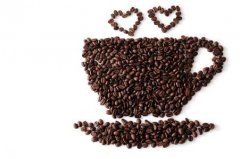Espresso contains less caffeine than regular coffee

A cup of regular brewed coffee contains 115 mg of caffeine, espresso coffee (and percolator brewed coffee) about 80 mg, and instant coffee about 65 mg. Decaffeinated coffee is not completely decaffeinated and is about 3 mg. A can of Coke contains about 45 mg of caffeine, Pepsi 38 mg,Mountain Dew 54 mg, and TAB47 mg. Tea contains about 40 milligrams of caffeine, while an ounce of chocolate contains about 20 milligrams.
Coffee is the world's most popular stimulant: four out of five Americans drink it, consuming more than 400 million cups a day. Scandinavian countries consume more than 12 kg per capita. The coffee industry employs more than 2.5 million people and is second only to oil in world trade.
Although coffee trees are thought to have grown near the Red Sea since the 7th century, the 15th century Arab writer Shehaddin Ben wrote that Ethiopians enjoyed coffee as long ago as anyone can recall. By the 16th century, coffee trees were found all over Arabia and Yemen. After the Turkish ambassador introduced them to Louis XIV's court in 1669, Europeans soon got a taste of them. Several years later, Dutch coffee was introduced to Java. In 1714, the Frenchman Desque stayed on Martinique Island and planted a coffee tree. Coffee cultivation soon spread from Guiana, France, to Brazil and Central America. Today coffee is grown in most parts of the world.
Coffee is the seed of the berries of the coffee tree, which produces about 1 kg (2 lb) of coffee a year. There are more than 25 coffee varieties, of which the three main commercial varieties are Robast, Liberi and Arabica, the latter accounting for 70% of the total production.
Caffeine enhances the potency of aspirin and other painkillers, which is why it is present in some medicines. Ironically, caffeine withdrawal is also one of the most common causes of headache. Women who drank two or more cups of coffee a day had an increased risk of osteoporosis. However, you can offset the loss by drinking milk or yogurt. Many studies have found that high caffeine intake impairs fertility, and drinking during pregnancy can lead to premature birth or birth defects.
Caffeine can be removed from coffee by treating green coffee beans with chlorinated hydrocarbon solvents. Instant coffee is made by mixing ground, roasted coffee with hot water, drying it in drying equipment and high pressure, and finally leaving only coffee powder. Some coffee products contain chicory, figs, dates, malt, or barley as coffee substitutes, far from real coffee.
Important Notice :
前街咖啡 FrontStreet Coffee has moved to new addredd:
FrontStreet Coffee Address: 315,Donghua East Road,GuangZhou
Tel:020 38364473
- Prev

The aroma and aroma of coffee the difference between smell and taste
Aroma is olfactory, fragrance is taste, this is the difference between aroma and fragrance in feeling. Aroma is the emotional communication between coffee and people, which brings people more spiritual and emotional experience and enjoyment; aroma is the pleasure of coffee to the skin to meet people's instinctive desires. One is metaphysical, the other is metaphysical. They don't come from the same substance at all.
- Next

Understand the importance of coffee in accompanying meals.
Today's urbanites are very particular about using different wines to match different foods, which is indeed an art. And when coffee generally enters the families of people in the capital, do you know as much about coffee as you know about wine? Have you ever considered whether Kenyan coffee, which goes with breakfast bacon, will still match when served with dessert? Coffee
Related
- Beginners will see the "Coffee pull flower" guide!
- What is the difference between ice blog purified milk and ordinary milk coffee?
- Why is the Philippines the largest producer of crops in Liberia?
- For coffee extraction, should the fine powder be retained?
- How does extracted espresso fill pressed powder? How much strength does it take to press the powder?
- How to make jasmine cold extract coffee? Is the jasmine + latte good?
- Will this little toy really make the coffee taste better? How does Lily Drip affect coffee extraction?
- Will the action of slapping the filter cup also affect coffee extraction?
- What's the difference between powder-to-water ratio and powder-to-liquid ratio?
- What is the Ethiopian local species? What does it have to do with Heirloom native species?

